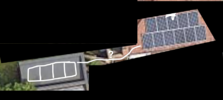Hello!
I'm asking for some advice on how I would go about adding 3 or 4 solar panels to my existing system.
Currently I have:
11 solar panels mounted on a pitched roof
Module Type: Kinve 250-60M
Inverter: SunnyBoy HF2500
Installed Capacity: 2.75 kWp (11 panels - 250W each)
Roof Orientation: South
I would ideally like to do this work myself. It is hard to get any solar installer to do this sort of work, as they want to replace the system rather than add to someone else's, and then it becomes prohibitively expensive.
As far as I can work out, since it is a string system, my thoughts are to:
1. Switch off the AC isolator
2. Switch off the DC isolator
3. Unplug the cables from the isolator inputs to the DC isolators
4. Fix mounting brackets to the adjoined, smaller roof
5. Somehow disconnect one of the connections on the end of one of the rows of the existing system, and connect it up to a new string of 3 panels (which is on the adjoined but much smaller roof)
6. Connect the end of the 3 new panels to the inverter, or back into the original 11.
Stages 1-4 seem pretty clear to me. I understand that I have to keep the wattage of any new panels exactly the same as the old. And I understand that I'll need a new inverter (I was thinking a SunnyBoy 3000).
But could someone explain like I'm 5, how to connect up the new solar panels, to the existing system? Do I need female and male couplers and perhaps some solar cable also?
Any advice much appreciated!! Thanks
I'm asking for some advice on how I would go about adding 3 or 4 solar panels to my existing system.
Currently I have:
11 solar panels mounted on a pitched roof
Module Type: Kinve 250-60M
Inverter: SunnyBoy HF2500
Installed Capacity: 2.75 kWp (11 panels - 250W each)
Roof Orientation: South
I would ideally like to do this work myself. It is hard to get any solar installer to do this sort of work, as they want to replace the system rather than add to someone else's, and then it becomes prohibitively expensive.
As far as I can work out, since it is a string system, my thoughts are to:
1. Switch off the AC isolator
2. Switch off the DC isolator
3. Unplug the cables from the isolator inputs to the DC isolators
4. Fix mounting brackets to the adjoined, smaller roof
5. Somehow disconnect one of the connections on the end of one of the rows of the existing system, and connect it up to a new string of 3 panels (which is on the adjoined but much smaller roof)
6. Connect the end of the 3 new panels to the inverter, or back into the original 11.
Stages 1-4 seem pretty clear to me. I understand that I have to keep the wattage of any new panels exactly the same as the old. And I understand that I'll need a new inverter (I was thinking a SunnyBoy 3000).
But could someone explain like I'm 5, how to connect up the new solar panels, to the existing system? Do I need female and male couplers and perhaps some solar cable also?
Any advice much appreciated!! Thanks
Last edited:


